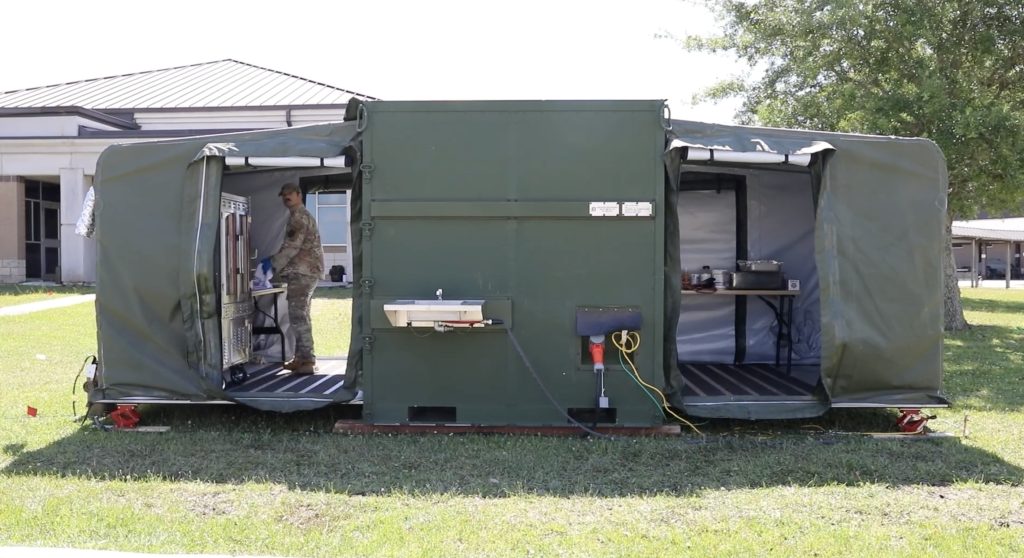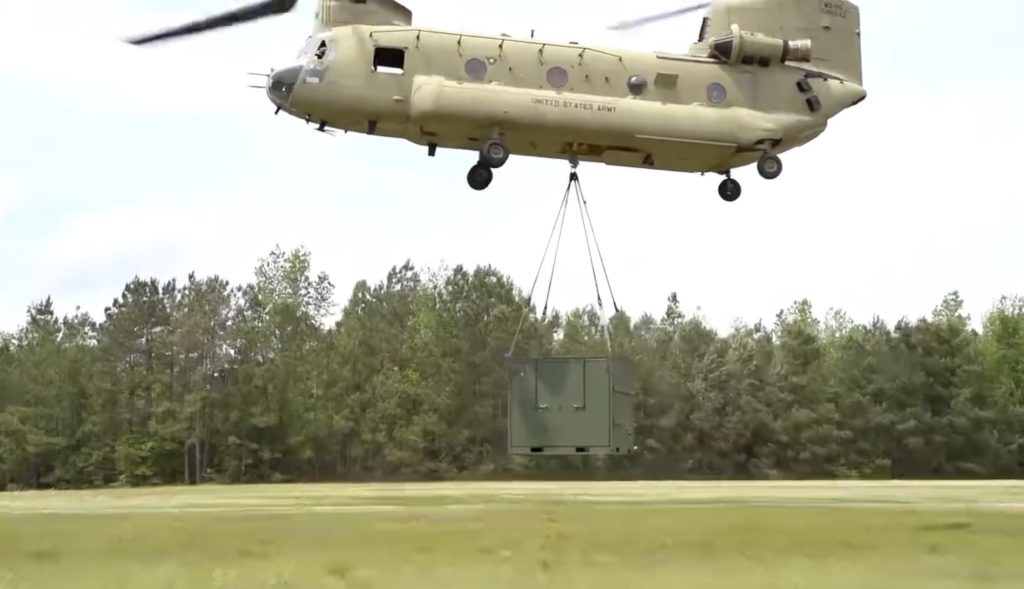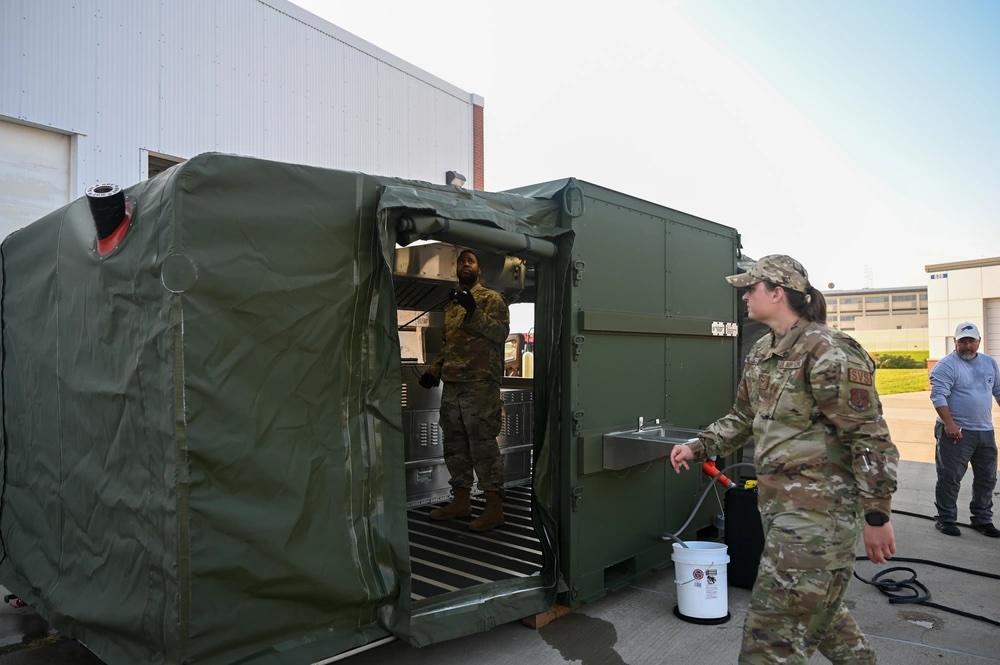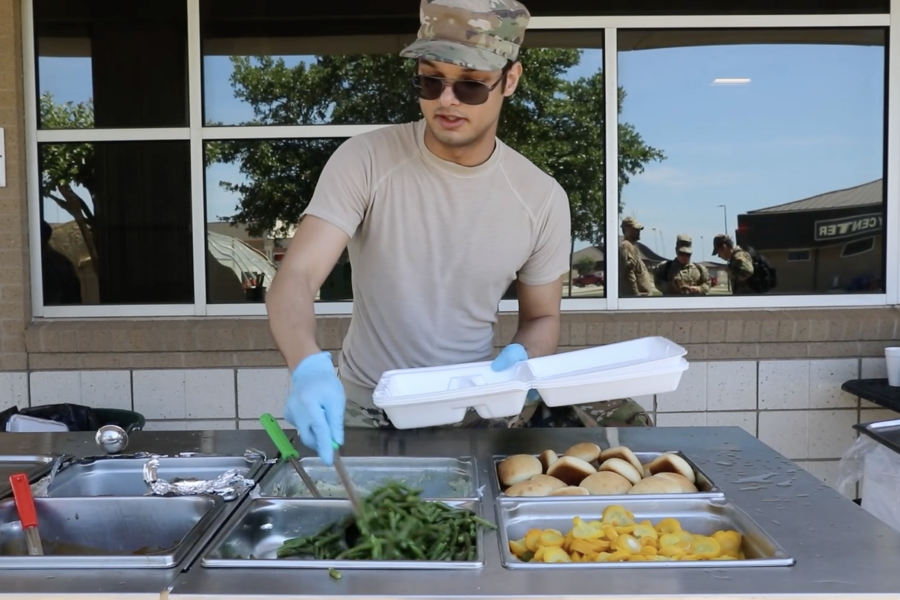As the Air Force pursues a strategy called Agile Combat Employment (ACE), where small teams of Airmen launch and recover aircraft at remote or austere airfields, one question persists: what are they going to eat?
While the military often relies on packaged Meals Ready to Eat for nutrients in the field, Air National Guard units around the world are enjoying fresh, hot meals made with a new field kitchen that can serve hundreds of troops in a shorter amount of time, make more kinds of food, and run far more efficiently than its predecessors.
The box-shaped Expandable Single Pallet Expeditionary Kitchen takes up just one standard aviation cargo pallet. Once in position, two of its sides fold down to form the floor of the kitchen while a tent-like material forms the roof and walls. Two people can complete the process in less than 15 minutes, the 127th Wing noted in a March 7 press release.
“We can cook almost anything with this. It’s completely self-contained,” said Tech Sgt. Anthony Renaud, a services craftsman with the 127th Force Support Squadron (FSS).
Prior to E-SPEK, the Air Force used the SPEK, which took up the same amount of space, a 463L pallet, but took four hours and eight people to set up, Chief Master Sgt. Dawn Porter, 127th FSS services manager, told Air & Space Forces Magazine. The tent covering was more complicated, and the floor was “like a puzzle,” said William Hague, a retired Marine lieutenant colonel and vice president of Babington Technology, Inc., which makes both the SPEK and the E-SPEK.
“It can take several hours to get the system set up and operational, and just as long to break it down and re-pack it out,” he said. By contrast, the E-SPEK requires relatively little assembly.
“You don’t have to do anything but roll a generator outside, bring a power cable over, and literally within minutes you can be heating up your appliances and get ready to start cooking,” he explained.

On March 7, the 127th FSS put E-SPEK to the test, serving up fresh burgers and chocolate chip cookies for lunch at Selfridge Air National Guard Base, Mich., within an hour of set-up. Last April, the Mississippi Air National Guard used one to make chicken, green beans, rolls, and more during Southern Strike 2023, a large-scale ACE exercise.
“This gives our members an opportunity to get a piece of home, to get baked cookies, to get scrambled eggs on the go, to get baked chicken,” Tech. Sgt. William George, a services specialist for the Mississippi Air National Guard, said at the time. “Everything that you would normally get at home, we can do it out of this.”
The SPEK was state-of-the-art when it was first adopted in 2003, Hague said, but the E-SPEK has more appliances, including a griddle, a 30-gallon skillet, a convection oven, a heated serving line that allows food to stay out for longer, and a three-component sink that rotates to save space.
“Now you can prepare the food in appliances that feel like your home or a restaurant kitchen,” he said.
The new appliances represent more than just added convenience: it also reflects a change in Air Force strategy. When SPEK first came on the scene, the military needed a kitchen that could feed an engineer unit while they built a larger forward operating base, Hague explained. Once the equipment for a larger, more permanent kitchen arrived, the SPEK could be packed away.
That was in 2003, near the start of the Global War on Terror, where the military stood up sprawling air bases across the Middle East. But now, as the Air Force prepares for small airstrips that can be packed up quickly to avoid being targeted by missiles, there are no larger kitchens coming to save the day.
“Roast beef, roast turkey, roast chicken, meatloaf, beef stew fresh out of the kettle, all of those were not possible in the original SPEK,” Hague said, but they are with E-SPEK.
The E-SPEK could prove useful outside of combat. Earlier this month, the Alaska Air National Guard used it in the field during a simulated natural disaster response exercise.
“Disasters like this bring a lot of chaos and you don’t often know what to expect,” Staff Sgt. Kua Xiong, a culinary specialist, said in a release at the time. “Our goal is to make life easier for those affected by disasters like this and get them fed.”
Two E-SPEKs can be loaded onto a standard 20-foot shipping container, but they can also be moved by airlift, flatbed truck, or sling-loaded from the bottom of a Chinook or Black Hawk helicopter. Sling-loading can be particularly useful when, for example, flooding cuts off the roads during a natural disaster.
“It can go places, with this capability, that our normal mobile kitchen would not be able to by road,” Maj. Dustin Eaves, force support officer with Mississippi’s 186th Air Refueling Wing, said about sling-loading an E-SPEK. “We can move it where we want to, drop it exactly where we need to.”

But while the E-SPEK itself is mobile, it needs food, water, and gas to make meals. The exact space requirements for those ingredients vary wildly depending on the kinds of meals, the number of meals, and the size of the unit being served. They might require a refrigerated shipping container or a dry stores container, or a multi-temperature container with one half frozen and one-half dry store. Last July, the Guam Air National Guard tried to use the E-SPEK to feed fresh meals to troops, but they had to resort to MREs for two days when their water delivery truck broke down.
All kitchens need food and water, but the E-SPEK needs about 75 to 80 percent less gas than a comparable, generator-powered, electric kitchen, Babington says on its website. Hague said a company of Marines got two heat-and-serve meals (pre-cooked entrées heated up with boiled water: not quite fresh but not MREs either) a day on less than five gallons of JP-8 fuel.
Other meals may require more or less power: Porter, the 127th FSS services manager, said the system needs 25 gallons for the initial start-up, followed by 10 gallons for a typical eight-hour day. But in general, greater fuel efficiency means the Air Force does not have to bring as much gas across the Pacific in the middle of a war. Future versions of E-SPECK could be even more efficient: Hague said Babington is working out how to power the kitchen using radio batteries fed by foldable solar panels.

So far, 21 E-SPEKS have been delivered to various Air National Guard units, with a 22nd due to ship to Puerto Rico later this month. The first was delivered to Hawaii in February, 2023, and Hague expects the Guard will buy about 98 in total.
More E-SPEKs could be on the way. In February, Babington announced that the kitchen had been selected by AFWERX, a branch of the Air Force Research Laboratory, for its Expedient Basing Challenge, an effort to field technologies that can “significantly reduce base setup response times from weeks or months to just hours or days,” AFWERX said in its challenge description. On its wish list are “Food technologies to provide high-quality and nutritious food for quick preparation while minimizing the footprint and need for kitchen facilities.”
Having been selected by AFWERX, E-SPEK is now qualified for Commercial Solutions Opening (CSO) procurement, meaning any Department of Defense organization can award contracts directly to Babington for the next 12 months with no competitive bidding or solicitation required, the company explained.
